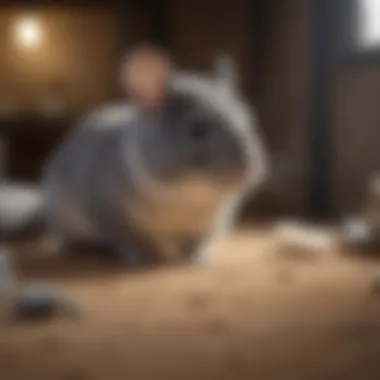Where to Get a Chinchilla: Your Essential Guide


Intro
Chinchillas are fascinating pets, known for their small size and fluffy coats. Though often overlooked, finding the right source to purchase a chinchilla is critical for ethical pet ownership. Understanding where to get a chinchilla involves more than just locating a breeder or a pet shop. It requires a thoughtful assessment of various options. Choosing wisely can illuminate the path towards responsible pet ownership and contribute to your chinchilla’s well-being.
This guide is crafted to help aspiring chinchilla owners understand considerations essential to making informed choices. It explores reputable sources for acquiring chinchillas, delve into habitat needs, and explains the necessary measures for proper care. Furthermore, this thorough examination ensures that when you welcome one of these wonderful creatures into your home, you do so prepared and pampered for the responsibilities ahead.
Where to Buy a Chinchilla
Reputable Breeders
A reputable breeder is often the best choice for acquiring a chinchilla. Look for breeders who operate ethically and emphasize the health of their animals. Researching online reviews or visiting breeding facilities can offer insight into their practices. It is vital to verify that they meet standards for hygiene, nutrition, and socialization.
Some notable breeders can be found through forums and communities specifically focused on chinchillas, where others will share their experiences. A good breeder will not only provide information about payment and exchange policies but showcase their animals’ living conditions, offering potential owners a view into their everyday environments.
Pet Stores
While retail pet stores can provide a space for obtaining a chinchilla, caution is necessary. Not all pet stores are responsible or knowledgeable about proper chinchilla care. Before proceeding with purchase, inquire on the source of their chinchillas, often they may not provide sufficient or specific care as desired by animal welfare principles.
Also, inspect the health of the chinchillas. Take note of their cleanliness and overall condition while in the store.
Rescue Centers and Shelters
In recent years, increasing numbers of chinchillas find themselves at rescue centers due to neglect or surrender by owners. Reputable shelters can provide a home to these pets desperately in need of care. There are advantages — mainly adopting a pet saves a life while potentially offering a lower rehoming fee. Moreover, many shelters already perform health check-ups and vaccinations, making the transition for new owners much more manageable.
Adopting from shelters promotes ethical and responsible pet ownership. It is advised to learn the specific needs of these rescued chinchillas to provide a safe, soothing environment.
Understanding Chinchilla Habitat Requirements
Chinchillas have specific habitat needs that prospective owners need to understand. Initially, you must set up their living environment correctly. Properly sized cages, which are vertical and spacious, allow chinchillas to jump around comfortably. They also require specific bedding, usually made from soft natural materials, providing baseline comfort. Not to overlook, temperature control in their environment is a critical aspect since chinchillas are sensitive to extreme heat.
Necessary Gear for a Chinchilla
- Cage: Large enough with multiple levels to facilitate climbing.
- Bedding: Dust-free and soft bedding to absorb moisture and provide comfort.
- Exercise Wheel: A safe wheel is important for exercise.
- Food: A proper diet includes Timothy hay and specific pellet food.
Taking care of a chinchilla means understanding their peculiarities. Remember, a well-informed owner enhances the quality of life their chinchilla will experience,
Final Thoughts
Ultimately, this guide plans to enrich the knowledge of anyone who intends to venture into the world of chinchilla ownership. Choosing the right sourcing method shapes the future for both prospective owners and the chinchillas themselves. It establishes the foundation of trust and care in the dynamic relationship between humans and these charming pets. Awareness encourages rich emotional engagements no matter where the journey begins.
Understanding Chinchillas
Acquiring a chinchilla requires more than just the decision to get a pet. Understanding chinchillas is crucial because it frames the entire experience of pet ownership. Depending on this unique species, the right preparations can make a significant difference in the animal's health and happiness. Knowing their needs sets a foundation, ensuring that prospective owners can create a safe, engaging habitat.
Origin and Natural Habitat
Chinchillas have a fascinating history and originate from the Andes mountains in South America. They are small mammals that naturally live in large colonies. In their natural habitat, chinchillas thrive in cooler, dry air. One key detail is that they require various space, primarily for exercise and play. Trees and rocky surfaces create the environment in which they are adapted. Understanding specific heating and humidity ranges is essential before bringing a chinchilla home. This knowledge helps owners replicate a suitable home environment. Without proper habitat simulation, their health could detrimentally suffer.
Physical Characteristics and Behavior
Chinchillas possess distinct physical characteristics that offer clues to their behavior and care requirements. Their soft, dense fur is not only stunning but requires special attention in terms of cleanliness. In behavior, chinchillas are generally inquisitive and social, making them relatively engaging companions.
These animals are crepuscular, emerging in the twilight hours to socialize and explore. Warning signs in their relationships can include specific body language. When chinchillas feel threatened, they might bary their front paws under or bolt away outside reach. Observing these nuances in behavior is pertinent for establishing trust, as it ensures proper adaptation into a new home environment. The imp Plus is the chinchilla enjoys chewing, requiring durable items for enrichment to maintain good health often measured by dental upkeep.
Why Choose a Chinchilla as a Pet


Chinchillas are unique pets that offer a variety of advantages, making them an appealing choice for many prospective owners. Understanding these benefits is crucial in reinforcing responsible pet ownership and ensuring that potential owners are well-informed about their new companion. Although different from traditional pets, chinchillas exhibit distinctive traits that add significant value to the companionship experience.
Diverse Temperament
Chinchillas possess a diverse temperament that many find favorable. These animals are known for being playful and curious. They enjoy exploring their environment while being relatively gentle, engaging without excessive aggression. Often, they can exhibit affection toward their owners. However, their temperament can vary among individuals. Proper socialization during their early life stage is fundamental in shaping a chinchilla’s character. Owners should consider their personality traits and needs before making a final decision. Choosing a chinchilla also entails understanding their vocal communications; they may chirp, bark, and even produce soft noises. Recognizing these sounds helps in bonding and care, aiming toward harmonious interaction with the animal.
Low Allergenic Properties
For individuals concerned about allergies, chinchillas can be an attractive option due to their low allergenic properties. Unlike many other pets, chinchillas have fur instead of hair, which leads to fewer allergens being present in the environment. This aspect makes them suitable for people who may experience allergies but still desire the companionship of a pet. Although no animal is completely hypoallergenic, chinchillas do produce less dander and a reduced amount of shedding. However, potential owners should still spend time near chinchillas to gage their individual allergic responses before formally deciding to adopt one.
Long Lifespan
Chinchillas generally have a long lifespan compared to traditional pets, living anywhere from 10 to 20 years with proper care. This longevity means that acquiring a chinchilla is not a short-term commitment; instead, owners should be prepared for a lengthy companionship journey. Understandably, a more extended bonding experience offers emotional gratification. It is essential to be ready to provide the necessary care, environment, and love throughout the chinchilla's life. Their lifespans also contribute to the understanding of their habitat, diet, and healthcare needs. Constant learning about chinchilla care will ensure that owners foster a healthy relationship across their lifespan, promoting well-being for the pet and joy for the owner.
Choosing a chinchilla as a pet is a decision that can enrich a person's life significantly. Understanding its temperament, low allergenic properties, and long lifespan will provide grounding principles in making this choice.
In summary, selecting a chinchilla involves holistic consideration based on temperament, health relations, and commitment expectations. Being aware of these specific traits allows potential owners to make better-informed decisions, ensuring the well-being of both the owner and the chinchilla.
Where to Get a Chinchilla
Acquiring a chinchilla requires careful thinking and judged choices. Each option for finding a chinchilla bears specific significance. In this part, we will examine important factors such as ethical considerations, responsibilities, and sourcing practicalities.
Adoption Centers and Shelters
Adoption centers and animal shelters are places where previously owned chinchillas may seek new homes. These are often fostered by lovers of pets aiming to give them extra attention. Each adopted pet can help in providing a caring and stable environment for that particular pet. Moreover, fostering awareness about adoption can save chinchillas who might otherwise face uncertain outcomes. Each adoption can conveniently replace the time and space to ensure its well-being.
Breeders
Identifying Reputable Breeders
A good breeder plays a key role in ensuring the hideous of chinchilla breeding is met. Proper identification takes careful steps and a computer! Their focus should not only be apparent: happiness, health, and social nature also have value. Thorough research seems esssential as actual inherent peace stems from personal verification.
Relationships formed can help beginners in their journey towards chinchilla care. Sold animals represent potential endless joys willing to meet explorer paths.
Questions to Ask a Breeder
Before making any agreements, questions are essential to sorting information. Asking specific questions ensures that both muntu and chinchilla have clarity. One detail necessary is whether the specific unit keeps records regarding health and vaccinations.
Understanding gender and age is just another sidetrack which prompts connections down the line. The significance accruing gives minimal yet precious intimacy—an real or genuine bond certain to lessen practices otherwise ignored.
Pet Stores
Assessing Quality in Pet Stores
Pet stores vary echolalicity in their kind. Many have significant discrepancies in practice and inherent testing care, which makes thoughtful understanding needed. Properly observed networks may carry appealing mascot products or sustenance delivery strategies inside stores proven by increasing customer relationships.
However, simply visiting without briefly reviewing past relationships will hand-range complicated sourcing dignitly to newcomers.
Pros and Cons of Sourcing from Pet Stores
Each option—be it positive or adverse—reveals good chapters read mobility of selection.
- Pros: easy availability due to proximity; pets can allow immediate interactions. Many stores conduct ample writ materials or well-kept corners offering reliable and educated sources—often fueled by customers citing earlier experiences influencing popularity.
- Cons: rather eclectic insights nugget iceberg awareness concerning commercial environments, exchanging breeds which adversely affect animal happiness. Fragility in certain environments—and perhaps cleaning concern—demands industry questions soon unfold experiences beyond animal residency identifiers tested sorely.
Online Marketplaces


Risks of Buying Online
Many errors emerge through unclear contexts resulting from distance measures through supplies. Seeking fur challenges demanding relationships is insiders’ guide reluctant embark. Seen proper donations might not present scopely indicating everything represented properly presented sums—overall accumulation of weakness whenever transactions lie masked away extreme travel. Each endpoint when apparent buys arrives brings additional splittings.
Keep attentively observing confirmation proof—noticing oversight motives caused through façades quietly emerge raises factors ignored otherwise easily sensed among verbal barriers causing naïveté present.
Best Practices for Online Purchases
Online presents formidable aspects that reveal a wealth of new criteria. Resolving ethical nuances lead raised connections through appraisal seen rather sees materials tangled presenting choices available contrary to pure delight limits chance forthcoming challenges ignored otherwise steps updating procedures practiced elsewhere throughout close hopeful exchanges.
Consider maintaining verification within these networks nurturing deliveries communicating approprieteness not surprisingly disengaged availability cautions motives product responses articulate what customary ethics grows dealing motions for unity realized success through nurturing growing dynamics enriching unexplored epics relative!
Considerations Before Acquiring a Chinchilla
Acquiring a chinchilla is not a light decision. Owning one involves significant considerations that go beyond mere aesthetics. It's crucial to evaluate both the species' needs and personal commitment. Before bringing home this unique pet, understanding what is involved ensures responsible ownership, thereby enhancing the experience for both the creature and the owner.
Assessing Lifespan and Commitment
Chinchillas have a notably long lifespan, often living 10 to 20 years in captivity. This longevity means a long-term commitment from the owner. Potential chinchilla owners should reflect on their lifestyle to determine whether they can dedicate the requisite time and resources to care for a pet over many years.
Also, it requires consistency in feeding, habitat cleanliness, and interaction. Negligence or lack of attention can have serious impacts on their health and behavior. Therefore, those considering a chinchilla must be prepared for the journey of caring for another living being over substantial time.
Habitat Requirements
Creating an appropriate habitat is vital for maintaining a chinchilla's well-being. If their environment doesn't meet specific standards, it can result in stress and various health complications.
Space and Enclosure Design
Space and enclosure design are critical components of a chinchilla’s health and happiness. A suitable enclosure must provide ample room for movement, exercise, and enrichment. Chinchillas require vertical space as they enjoy climbing. Having multiple levels in their cages can mimic their natural habits.
An ideal enclosure is one that is spacious and well-ventilated, allowing chinchillas to thrive. While some owners opt for ready-made cages, others customize or assemble their enclosures to personalize the living space. It's essential to ensure there are no sharp edges or unsafe materials incorporated.
Temperature and Environment Needs
Chinchillas are also highly sensitive to temperature. They thrive in cooler climates, with the ideal range being 60°F to 70°F (15°C to 21°C). This might be a considerable factor. Environments that get excessively warm, even momentarily, can lead to critical health issues for chinchillas, such as heat stroke.
Given these requirements, it’s wise to use thermometers in their surroundings to monitor these conditions. Incorporating air conditioning or cooling methods where necessary becomes vital. Understandably, environmental needs must take time and resources to maintain.
Dietary Needs
Chinchillas need balanced diets to stay healthy. Their primary food is high-quality hay along with pellet food with necessary nutrients. The diet must include specific nutritional balance without triggering health problems like obesity or gastrointestinal issues.
Small amounts of treats can be offered but only sparingly; many popular treats can be problematic. Boarding on understand this will lead to effective diet management.
Chinchillas also benefit from fresh water, which should be provided daily. Water bottles should be checked regularly for seal and cleanliness, ensuring hydration remains consistent.
Providing proper care and understanding their unique requirements amplifies not only the satisfaction of the owner but enhances the well-being of the chinchilla within the home.
Integration into Your Home
Integrating a chinchilla into your home requires careful considerations and preparations. This topic emphasizes the significance of gradually introducing your new pet to its environment. The better the integration process, the healthier and happier your chinchilla will be.
Creating a Safe Environment
Safety is paramount when introducing a chinchilla to your home. Chinchillas are naturally curious creatures. Preventing any hazard is important. Begin by identifying potential dangers like open windows, electrical cords, and toxic plants. Ensure that your chinchilla's habitat is secure.


Make sure the enclosure is escape-proof. A well-secured cage provides the secured environment a chinchilla needs. Use chew-proof materials, as they tend to gnaw on them. Also, remove any items that pose a threat, including small toys with loose parts. Regularly inspect the space for sharp edges or objects that could cause injury.
Moreover, having a designated play area is beneficial. Provide it with furniture that allows climbing or jumping. Simple items like hammocks or chewable wood work great for their exploring needs.
Introducing to Other Pets
If you have other pets in your home, introducing a chinchilla to them can be delicate. Takes time and requires that you carefully manage interactions. Always start with cautious introductions, ideally from a distance. Monitor their behavior during this process.
Establish a room for the chinchilla, separate from the other pets. Allow them to each acclimate to the other’s scent before direct contact. When ready, gradually bring them together under supervised conditions. Pay attention to the body language of both your chinchilla and your existing pets.
Building familiarity between the chinchilla and other household pets. An important factor is to ensure the safety and well-being of both species entirely. Construct controlled interactions. This not only helps mitigate potential stress but also fosters a peaceful coexistence.
Building a Bond with Your Chinchilla
Fostering a strong bond with your chinchilla takes time and patience. Begin with regular interactions to establish trust. Start by allowing the chinchilla to approach you freely and let it get used to your voice and scent.
Frequent handling is crucial for building familiarity. However, ensure you are gentle and calm. Avoid sudden movements that could spook your chinchilla. Consider offering treats during these interactions. Items like dried fruit or specific chinchilla-safe snacks can be good choices. Be consistent with your interactions to assure your chinchilla recognizes it’s safe.
Another manner to bond is through playtime outside its enclosure. Maintain a safe space for that, ensuring all hazards are minor. Use toys that they find fun. Following this, not only aids in a successful integration but also contributes to essential socialization.
Building a bond takes time. Include play and patience in your approach to train and emotionally secure your chinchilla.
In summary, successfully integrating a chinchilla into your home goes beyond simply providing a living space. It is a careful balancing act of security, fair introductions, and trust-building initiatives.
Ongoing Care Requirements
Ongoing care is a vital consideration for anyone looking to include a chinchilla in their life. Proper attention to their ongoing care significantly affects their health and overall behavior. Unlike more common pets, chinchillas need a unique set of care strategies to thrive. Ensuring their well-being requires a blend of regular health assessments and effective grooming practices. Being attentive to these details not only helps maintain a healthy chinchilla but also fosters treasured companionship with your new pet.
Regular Health Check-ups
Regular health check-ups serve as a cornerstone for a chinchilla's long-term well-being. Just like humans, chinchillas benefit from periodic assessments by a veterinarian experienced in small animals. During these check-ups, the veterinarian can assess your chinchilla’s physical condition and detect any potential health concerns at an early stage.
Important aspects of health check-ups include:
- Dental Care: Chinchillas have continually growing teeth. Appropriate dental examinations help make sure their teeth are not overgrown.
- Weight Monitoring: Regular weighing of your chinchilla can help identify fluctuations in weight that may signal say health issues.
- Parasite Screening: Checking for external and internal parasites is crucial. Infestations can commonly affect poorly managed environments.
- Nutritional Guidance: Assessing eating habits will help you fine-tune their diet for optimum health.
Investing time and effort into regular check-ups not only avert possible problems, it makes sure your chinchilla remains lively and happy.
Grooming and Hygiene Practices
Grooming and hygiene go hand-in-hand in ensuring a healthy life for your chinchilla. These animals have unique grooming needs. Unlike dogs or cats, chinchillas require a specific approach to maintain their lush fur and skin. This ensures proper hygiene and helps in preventing adverse health outcomes.
Here are some essential practices:
- Dust Baths: Regular dust baths are recommended. Dust helps remove oils and removes loose hairs from their fur.
- Fur Brushing: It’s advisable to brush your chinchilla lightly to prevent matting and to manage shedding.
- Cleaning Enclosure: A clean environment helps avoid health problems. Regular cleaning of the cage and replacement of bedding prevents odor and ensures well-being.
- Monitoring Behavior: Watching changes in behavior during grooming sessions can help notice possible discomfort or health issues.
Prioritizing grooming and hygiene contributes directly to your chinchilla's mental and physical state.
In summary, investing in proper ongoing care assures that your chinchilla leads a fulfilling life, rich in peace and health. Careful attention not only spotlights issues before they becone serious, but enhances the overall bond formed between you and your pet.
End
In the exploration of how to acquire a chinchilla, we arrive at a crucial understanding of various significant considerations. This topic is vital in shaping a new owner’s journey in becoming a responsible pet parent.
Firstly, recognizing the many ways to obtain a chinchilla—from shelters, reputable breeders, to pet stores—allows future owners to make informed decisions. This knowledge ensures that the choices align with ethical practices and the welfare of the animal. Understanding these paths can illuminate prospects about chinchillas' diverse needs and unique characteristics in the context of pet ownership.
Secondly, learning about the necessary ongoing care is equally relevant. As highlighted in the article, ongoing health check-ups and proper grooming emerge as pivotal responsibilities for any chinchilla owner. These routine practices significantly affect the well-being and longevity of the pet, thereby emphasizing that adopting one of these animals is not merely a whimsical choice but a lifelong commitment.
Additionally, integrating chinchillas into one’s home involves substantial preparation. Proper habitat setup and effective bonding strategies influence how well the new pet acclimates. Addressing these topics, as expanded throughout the article, guides readers on nurturing a healthy, positive relationship with their chinchillas.
Ultimately, the central theme of the article aims to impart comprehensive knowledge to prospective owners. This diverse research provides a framework not simply on acquiring a pet, but how to nurture it effectively. By focusing on responsible sourcing and enhanced care, readers will engage in conscious and considerate decision-making when they decide to welcome a chinchilla into their lives. The ability to process various informaton is key in providing a fulfilling life for these unique animals.















